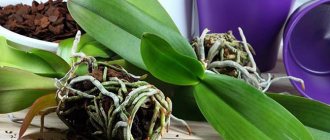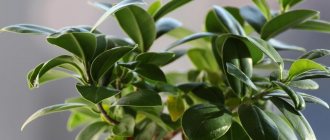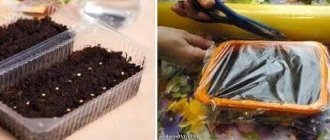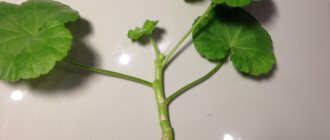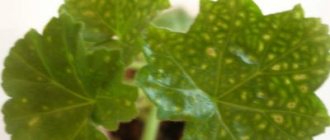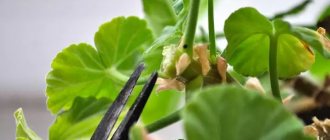What determines the fluffiness of geraniums?
Flower growers value geranium, also called pelargonium, for its unpretentiousness, abundant flowering and decorative appearance. When growing it, it is important to know the peculiarities of flower formation: how to prune pelargonium to get an attractive fluffy bush with abundant and long-lasting flowering.
There are several important factors in care that determine how decorative and fluffy a flower will be.
Firstly, this is lighting. Geranium is a light-loving crop. If you do not take care of it and grow it in a lack of light, the lower leaves fall off, the branches begin to stretch strongly, and the stem becomes bare.
A sufficient amount of nutrients during the growth period is an important factor in care. It plays a significant role in the growth of green mass and the formation of a well-leafed fluffy bush. With a lack of microelements, the growth of pelargonium may slow down, the leaves turn yellow and fall off.
The third and most important factor is proper crown pruning. It is necessary to prune pelargonium, as this care procedure allows you to awaken dormant buds and get a fluffy bush. Pruning is also important for setting inflorescences and abundant flowering.
Peculiarities
This is a perennial crop that looks like a branched bush, the height of which is 1 m. The root system is highly developed, and the leaf blade is bright green. The inflorescences are small, their color is white or pink, and the number of petals is 5.
Not all varieties of fragrant geranium can bloom ; some types are kept by gardeners due to the decorative appearance of their foliage and pleasant aroma. When flowering is completed, the fruit appears in the form of a box. This is where the seeds will ripen.
Medicinal indoor geranium produces a pleasant aroma thanks to the small glands that are located on the outer and inner sides of the leaf plate (read about the medicinal properties and contraindications of fragrant geranium here). They are filled with essential oil.
To experience an incredibly pleasant aroma, simply rub a few geranium leaves with your hands.
What does geranium need for fluffiness?
To get a decorative fluffy geranium bush, it needs to be pruned according to certain rules in spring and autumn. This care procedure stimulates active growth and lush flowering of pelargonium, as the buds on the sides of the main shoots are activated and flower buds are formed.
When caring for a flower throughout the growing season, it is necessary to pinch the side branches above the 4th leaf node; if there are too many of them, remove some of them.
How to care for geraniums so that they are fluffy
In order for geraniums to be fluffy, they must be properly cared for from the very beginning of cultivation.
When planting geraniums, you need to choose the right size pot. Experienced gardeners do not recommend planting this flower in large containers, as it will not grow and bloom well until the roots have filled the entire volume of the pot.
Geranium comes from the arid regions of Africa, so it can hardly tolerate stagnant moisture. You need to take care of it in such a way that it is better not to top it up slightly than to overfill it. But in summer, on hot days, moisture evaporates more intensely, so it is recommended to increase watering.
Care is as follows: water only with warm water; cold water will cause stress in the pelargonium and cause leaves to fall off. Also, pelargonium does not require spraying; frequent contact with water on the foliage can cause it to turn yellow.
It is recommended to fertilize every two weeks during the growth period. You can use ready-made fertilizers for indoor flowers, apply according to the instructions.
How to prune geraniums to make them fluffy, step by step photos
You need to prune geraniums to form a bush according to the following scheme:
- Examine the plant in order to understand which branches stand out from the general mass, are too long, crooked or thin, and what shape you would like to give the flower.
- Prepare cutting tools. They should be sharp; you can use a knife with a thin blade or a scalpel. It is not advisable to trim with scissors, as they squeeze too much when cutting and damage the tissue of the stems. Treat instruments with alcohol or other antiseptic to prevent pathogenic microflora from being introduced into the sections.
- If there is withered and dry foliage, trim that too. Trim all uneven and damaged branches. Weak side branches need to be pruned, since a bush that is too thick is also bad. Leave only strong, healthy shoots.
- If there are small short shoots on the sides at the base of the remaining shoots, then they should be trimmed. Trim long main shoots to 1/3 of their length, and trim secondary shoots at the level of the 4th or 5th leaf node.
- Sprinkle all cutting areas with charcoal powder. If you don’t have it, you can replace it with crushed activated carbon tablets. 3-4 days after pruning, it is advisable to feed the geranium with fertilizer containing nitrogen. This feeding will help the geranium recover and increase its green mass.
ATTENTION! To form a fluffy bush, one-time pruning is not enough. You need to take care often and, most importantly, regularly. During the entire growth period, it is necessary to monitor the growing branches and periodically pinch them at the level of the 4th bud.
Basic rules of these procedures
- For pruning, use only clean, disinfected, sharp tools. It could be a razor, a knife. Pinching is done only with clean hands, so as not to provoke the occurrence of any disease in the flower.
- After pruning and pinching, the plant needs plenty of light, otherwise new shoots will stretch.
- Branches growing inwards must be removed, as they prevent light from entering and normal air exchange, which leads to the occurrence of diseases.
- If there is a large distance between pairs of leaves, then the cut is made immediately above the leaves.
- Diseased shoots need to be cut only to the healthy part, capturing 3-5 cm.
- It is advisable to treat the sections with brilliant green, alcohol, and an antifungal agent. Untreated cuts can dry out and the bush will look unpresentable.
When to pinch a plant grown from seeds?
You need to pinch pelargonium from seeds after the first 5-7 leaves appear. This is considered the optimal length of the stem, since if you pinch later, you may not achieve the fullness of the flower.
When a bush has a large number of new side shoots, they also need to be pinched in those places where there are the most leaves. You can pinch the flower until it takes a suitable shape.
Young bushes grown from seeds cannot be pruned.
Features of the procedure at home
It is recommended to pinch pelargonium in February or March, as at this time the plant is preparing for new flowering.
But, if you only need to adjust the volume of foliage and flowering, then you can pinch it both in the summer and in the second half of spring. It should be remembered that pinching slows down the growth of new inflorescences. The pinching procedure is as follows:
- First you need to examine the plant and assess its condition after winter. Understand whether pinching will be enough, or whether it needs pruning.
- Treat the necessary tools and hands with a disinfectant. Do not pinch the flower with dirty hands.
- Then pinch out the elongated shoots. If pelargonium is grown from cuttings, then you need to pinch over 8-10 leaves. And if from seeds, then you need to leave 2 fewer leaves.
- Next, small shoots growing inside the flower are removed. The middle of the plant should be free for normal air circulation. If the air and moisture stagnate, there is a high probability of fungal diseases occurring.
- If the shoots are affected by the disease, then pinching will be useless. They will have to be cut back to a healthy area.
- You need to pinch immediately above the leaf, do not leave excess, otherwise it will spoil the appearance of the pelargonium.
How to choose the time to prune geraniums
You can prune geraniums in spring and autumn. Spring pruning is considered the main thing in care, since it is it that allows the bush to form a fluffy shape and stimulates lush flowering. It is carried out immediately after winter, as soon as daylight hours increase, usually from the end of February to mid-March.
IMPORTANT! When pruning in spring, you cannot prune more than 1/5 of all shoots, since with such a radical approach, flowering may occur only closer to autumn or in the next season.
To maintain a beautiful geranium crown, during the entire growing season it is necessary to carry out a care procedure such as pinching. It consists in removing the upper growing point, which forces the geranium to produce lateral shoots. It is thanks to pinching the tops that the fluffy shape of the geranium will be preserved.
Autumn pruning can be called sanitary. It is carried out in October, after flowering. It consists of removing dry peduncles, branches and leaves, and shortening excessively long shoots.
If the flowers spent the whole summer outdoors, then in the fall you need to bring them indoors and give them a couple of weeks to adapt. Only then prune, otherwise the geranium will experience stress and may get sick.
When should you not prune geraniums?
In winter, daylight hours are short and flowers often lack light. You need to take care of the crop a little differently. Sun-loving geranium is dormant at this time. Plant growth is slow.
If you trim, you can get the opposite result of what you want: a sparse crown with thin, long shoots.
This happens because pruning stimulates the growth of shoots, but there are few of them, they grow thin and weak due to lack of light. In addition, during the dormant period, geranium is difficult to tolerate any manipulations in care.
Caring for geraniums after pruning
After spring pruning, which is carried out immediately after the dormant period, the geranium is moved to a more illuminated place. If in winter the flower pot was in a cool room, now you can move it to a warmer place. Gradually increase the amount of watering and begin to fully care for them.
After wintering, the growth of geraniums is activated, dormant buds awaken and young shoots appear. It is very good to treat plants with epin. The drug is diluted according to the instructions; the flowers are sprayed on the foliage three times a month.
Other care will be required after autumn pruning. Cold winter is approaching, when the growth of geraniums slows down greatly, or even stops altogether. It is important to properly care to prepare the plant for this period.
Immediately after pruning, geraniums should be fed with nitrogen fertilizers and provided with additional lighting with lamps on cloudy days. This way she will recover faster and gain strength.
2-3 weeks after pruning, the geranium must be moved to a cooler room with an air temperature of +10-140C. Gradually reduce watering to once every 7-10 days, watering as the earthen clod dries out.
IMPORTANT! A little more about how to properly care for it. Spraying after pruning geraniums is not required, as excessive moisture can cause the development of fungal diseases at the cut sites.
Microclimate
- Lighting . Fragrant geranium feels comfortable on a warm and bright windowsill. It is best to choose windows facing south, but direct sunlight is not harmful to the plant, but on the contrary, if there is a lack of it, flowering will be scanty or absent altogether. Hanging baskets and pots are great for growing geraniums.
- Temperature . In winter, the plant will feel comfortable if the temperature is maintained at 8-10 degrees Celsius, but in summer it will be 25-30 degrees. In summer, the flower can be taken outside or onto the balcony.
- Humidity . Fragrant house geranium has the ability to concentrate water in the stem and leaves. Thanks to this, it does not require spraying and will not tolerate excessive soil contamination. The optimal humidity level for a flower remains 60-70%.
Tips and tricks for gardeners
It happens that a gardener receives geraniums that have never been pruned. It consists of one or two long stems with leaves at the top. In this case, experienced gardeners advise cutting off the branches completely once at a distance of 10-15 cm from the ground. The plant will produce young shoots, and in the future they can be used to form a fluffy bush.
To make the geranium look fluffier, several cuttings can be planted in one pot. But you will need to form such a bush in the same way: prune it in the fall and spring, and during the growing season properly care for it and pinch out the side shoots as necessary.
Pelargonium propagation
Geranium reproduces well by dividing the bush (this is done during transplantation) and cuttings. We place the cutting in a glass of water, and as soon as the roots appear, it’s time to transplant it into a pot. Many (including us) prefer to place cuttings outside of water (there is a risk of rotting before
the appearance of good roots), and immediately into moist soil: it’s more reliable.
Propagation by cuttings is a very simple and quick way to get a new plant. The top of an adult plant (or powerful side shoots) with 2-3 leaves is cut off, the cut is rolled in crushed activated carbon, the cutting is allowed to lie for several hours (but no more than half a day) and then planted in the ground.
Common mistakes
There are several mistakes that beginners in floriculture most often make when caring for a geranium bush:
- Pruning in winter leads to weakening of the plant, development of weak shoots and lack of flowering in the future.
- Cutting the stem too high above the leaf node causes the top to dry out.
- Drastic pruning, when the procedure is carried out too short and an excessive number of shoots are removed. This leads to a long recovery of the flower, as a result of which the rate of shoot growth slows down, and flowering does not occur for a long time.
- Cutting branches very often also prevents the plant from recovering and slows down the development of new buds.
- Failure to disinfect the tools used to prune geraniums can lead to infection by harmful fungi and bacteria.
Answers to frequently asked questions
Is it possible to prune in December?
No, at this time the plant is resting, vegetative processes are slowed down. It is worth postponing the procedure until spring.
Geranium stretches a lot during the winter, how to avoid this?
Place the plant in a cool, bright room and reduce watering.
To get fluffy pelargonium, how long after planting a young plant will it be necessary to form it?
The first shaping involves pinching the top of the young shoot. It should be carried out within 3-4 weeks after planting. Then prune the branches as the pelargonium grows.
Formation of a standard tree
To form a strong trunk, it is necessary to attach it to a flat vertical support. The side shoots that appear on it are cut off after the formation of the fourth leaf on them. The leaves are kept on the stem itself. When it has grown to the desired size, the foliage is removed and the top is regularly pinched. This contributes to the formation of a dense crown. Geraniums will begin to bloom no earlier than in a year.
The flower is placed in a warm, bright place where there is no direct rays of the sun. Abundant watering and frequent fertilizing serve as accelerators of the process.



